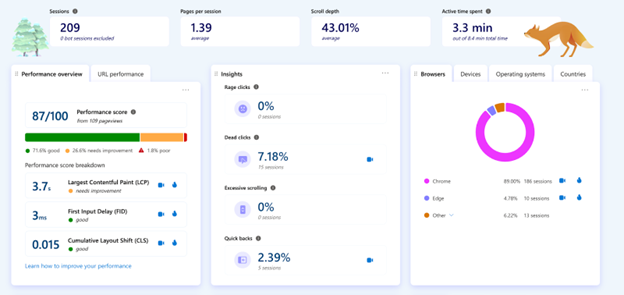I’m going to ask an easy question. What’s the point of an online store?
Well, on the surface, there’s a simple answer: to sell products. But underneath that statement, there’s a whole world of complexity that comes with the second goal of “providing a positive experience for your customers.” There are countless touch points along the way that could prevent people from purchasing from your online store. Imagine you have a physical store, and when a customer comes in to buy some cheese, they find that the cheese is on the top shelf, and they need a ladder to climb up and get to it. Sounds like that person is not going to buy that cheese, right? Maybe 1 in 30 will find an employee and ask for a ladder, but most likely, that person is going home without cheese. On the web, there are so many friction points that prevent users from having a positive experience and buying your cheese (or whatever you sell). The good news? There are amazing tools out there that provide insights into these friction areas, so that you can identify and ultimately solve many of the issues that are preventing users from purchasing.
And that’s what we are going to talk about today. Here are 10 strategies on how to use behavior analytics to enhance a user’s experience on your online store and, therefore, optimize your sales.
Utilize Heatmaps to Understand What People See and What They Don’t

In your imaginary physical store, would you put some awesome product information in the very back? Probably not. Companies invest a LOT of time into content and specific elements on their site, assuming that these will help provide information or interaction to increase the likelihood of conversion. The problem is that oftentimes, people don’t see a lot of it. While every website is different, there is generally a drop-off effect the further down your content is on the page. Imagine someone having to scroll to get a look at your products; you can bet that there will be significantly fewer clicks to cart compared to if that person saw the product right away. To understand what people are actually seeing, you can utilize heatmaps to identify which areas of your website attract the most attention and which ones are being overlooked. You can then use this information to optimize your layout and content placement on the page.
Optimize Load Times

Let’s say a person arrives at your imaginary cheese store and sees the line is out the door. They might suck it up and wait in line to get their super bowl party cheese platter rather than driving across town to a different cheese store. The switching costs are higher. It takes a lot of effort to go to a competitor at this point. On the web, it’s totally different. Your users could leave and be at your competitors with only a couple clicks…the longer your site takes to load, the more likely that user is going to bounce and look at competitors. Luckily, you can analyze page load times to ensure a seamless user experience. Tools such as Microsoft Clarity and Google’s PageSpeed Insights can give you metrics on speed and help identify and address any bottlenecks that may be causing slow loading speeds, as this can significantly impact conversion rates.
Identify Valuable Elements

Oftentimes, sites include an overwhelming amount of content areas & elements that they assume are valuable for the customer on the pathway to conversion. However, it can be hard to distinguish what’s actually valuable and what’s just noise. Purchase conversion heatmaps can help identify which areas are genuinely interacted with or seen on the pathway to conversion. By focusing on enhancing these elements, you can encourage more interaction and conversions, ensuring that your efforts are directed towards the most impactful aspects of your site.
Pinpoint Drop-off Points with Funnels

Let’s face it, every site has problems, whether you want to admit it or not. It’s okay; I’m not here to judge you on your sub-ideal checkout funnel. However, what I will judge you on is if you simply accept that it could be better and just twiddle your thumbs doing nothing about it. Funnels can help you identify which parts of the website need improvement and where the largest friction points are. Set up funnels to track the user journey through your website, from landing to purchase. By identifying the points where visitors are most likely to drop off, you can focus on improving those areas to increase conversion rates and create a more seamless user experience.
Find and Resolve Friction with Click Behavior

I just think the phrase “rage click” is too funny. It’s the equivalent of someone coming into your physical store and punching and kicking the shelves out of frustration. Can you imagine that? While that might be a bit hyperbolic of the situation, the same idea applies to your website. People get frustrated when they think they should be able to do something but can’t. This frustration not only hurts your reputation but also your sales. Fortunately, heatmap tools and session recordings can help you identify where people are having extremely negative experiences on your site, allowing you to fix these issues. By analyzing click behavior, you can pinpoint areas of friction or confusion on your website. Use this information to streamline the user experience and make it easier for visitors to navigate and complete purchases, ultimately reducing those “rage clicks” and boosting customer satisfaction.
Leverage Session Recordings for Insights

Watching what happens during a visit can help you identify a user’s experience. The problem, though, is that to truly identify patterns, you’d have to watch a ton of recordings, and no one wants to sit there for hours watching countless sessions (or maybe you do, but you should probably just keep that to yourself). The good news is that Microsoft Clarity offers a feature called CoPilot, which allows you to grab as many sessions as you want and have AI go through and summarize them for you. By segmenting the data with filters, you have a pretty powerful experience identifier at your fingertips. You can watch these session recordings to gain a deeper understanding of how users interact with your website, identifying common patterns, struggles, and opportunities for improvement based on real user behavior. This invaluable insight can help you make data-driven decisions to optimize your site and create a more user-friendly experience.
Segment Your Audience for Targeted Optimization

Picture this: a group of Girl Scouts and a group of motorcycle enthusiasts walk into your store. They’re probably going to shop very differently (though there might be some surprising overlaps—I’ll let you figure out what those could be). Identifying user segments through behavior analytics allows you to understand patterns based on factors such as user type, device type, and referral source. First-party data gathering techniques, such as quizzes and surveys, can help you capture information, while CDPs (Customer Data Platforms) can help retain and leverage that data. Tie that into your experience analytics tool, and you can have a much better sense of how specific groups are using the site. By tailoring your optimization efforts to each segment, you can create a more personalized and effective user experience. The more customized the experience, the more likely visitors are to convert. So, whether you’re dealing with cookie pushers, leather-wearing daredevils, or those who identify with both(!), segmenting your audience and delivering targeted experiences can make a world of difference in your conversion rates.
Conduct A/B Testing

We all have our pride and opinions, and sometimes we make guesses about what changes to our site will move the needle. But let’s be real, this practice can lead to plummeting conversion rates and a whole lot of wasted time and effort. That’s where A/B testing comes in—a wonderful tool to help you separate truth from mere speculation. Don’t just guess; learn with data! Utilize A/B testing, with tools like Convert.com, Optimizely, or AB Tasty to experiment with different versions of your website elements, such as call-to-action buttons, product descriptions, and layouts. Then, use behavior analytics to determine which variations drive the most engagement and conversions. By letting the data do the talking, you can make informed decisions that will keep your conversion rates soaring and your time invested wisely.
Integrate with Other Tools for Holistic Insights

Don’t you just love saying the word “stack”? Besides being fun to say, having an analytics stack can be crucial for your business. Different platforms offer different advantages, and by combining them, you can gain a comprehensive understanding of your users’ journey. Marketing analytics tools (such as GA4 or Piwik PRO) can provide detailed information about where people come from and how they arrived at your website. When combined with behavior analytics, this data can paint a broader picture of the user journey. But wait, there’s more! Mix in Customer Data Platforms like Segment, and you can start to truly understand an entire user’s lifetime value to your business. Use these insights to make data-driven decisions and create a cohesive marketing optimization strategy.
Continuously Monitor and Adapt

“Nothing lasts forever” and “a picture is worth a thousand words”—these two phrases pretty much sum up this point. In the digital world, you can’t just set it and forget it. Digital trends are constantly evolving, and if you don’t keep up, you might end up like Blockbuster (DON’T BE BLOCKBUSTER). To stay ahead of the game, build visualizations that allow you to regularly review your behavior analytics data. This way, you can keep your finger on the pulse of changing user preferences and trends, and quickly see what matters most. By continuously adapting your strategies based on the insights you gain, you’ll be ensuring ongoing success. Think of it as a never-ending cycle of improvement—kind of like your daily skincare routine, but for your website (more lotion, don’t let it dry out!). Continuously adapt your strategies based on the insights gained to ensure ongoing success.
Implementing these 10 strategies and leveraging behavior analytics tools will help ecommerce websites’ performance and sales thrive. By diving deep into user behavior, identifying those annoying friction points, and continuously optimizing your site, you’ll be creating a powerful experience that turns users into customers. Remember, the ecommerce landscape is constantly evolving, so it’s crucial to stay agile and adapt your strategies based on the insights gained from behavior analytics. Continue to invest in enhancing the experience for your customers and you will see continued success! (unlike Blockbuster…poor Blockbuster).
About the author
Josh Silverbauer is a highly accomplished analytics and conversion rate optimization (CRO) expert, known for his ability to combine complex analytics concepts with music & humor…With over 10 years of experience, he has consulted with some of the world’s largest brands, and has spoken at major events like SXSW & MeasureSummit. Josh is currently the Head of Analytics and CRO at From The Future, a CX & performance growth agency, and previously served as CEO of Great Big Digital Agency for 6 years.
